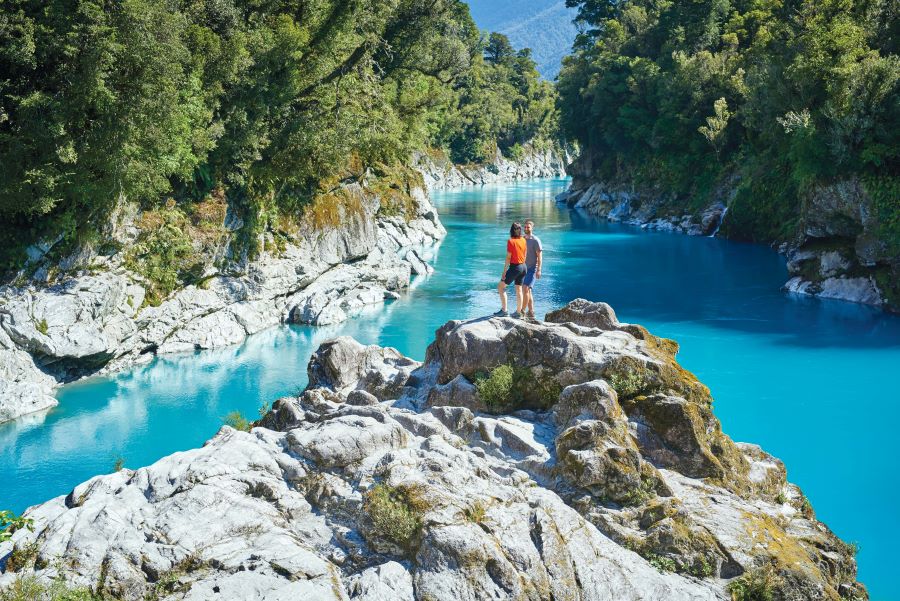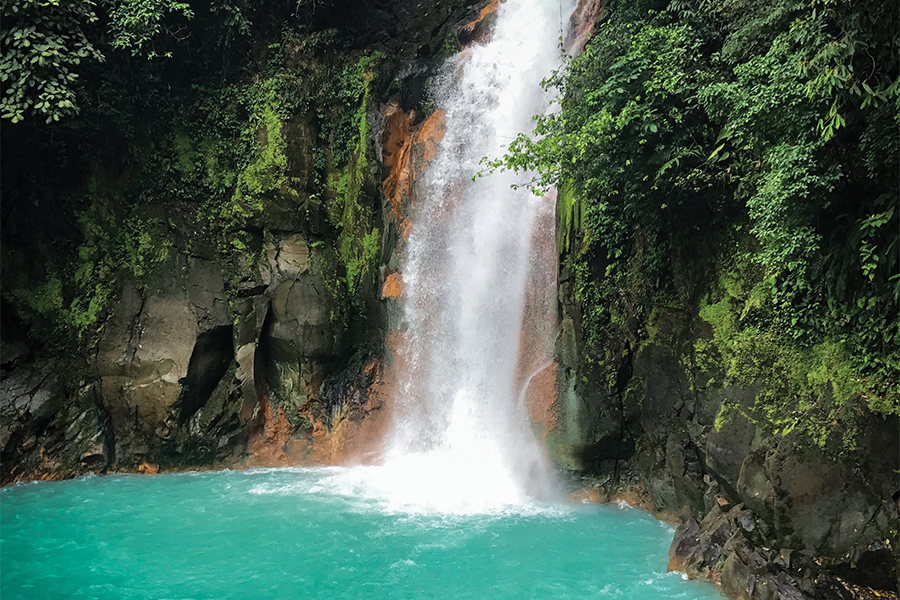New Zealand Adventures by Land and Sea

New Zealand has been a beacon for curious visitors for centuries. Polynesian settlers came by canoe, European explorers arrived during the Age of Discovery, and today, holidaymakers come by jet plane and cruise ship—lured by staggering scenery, world-class adventure and the vibrant culture of Indigenous Māori people. Touring the interior or sailing between ports, suffice to say, New Zealand is the trip of a lifetime.
The Lay of the Land
Located 1,000 miles east of Australia in the southwestern Pacific Ocean, New Zealand—named Aotearoa in the Māori language—is an island country made up of two main landmasses surrounded by about 700smaller islands. Long and narrow with over 9,000 miles of coastline, New Zealand boasts rich marine resources and a diverse landscape—from patchwork plains, deep fjords and alpine peaks of the South Island to the volcanic field and dense forests of the North Island.
“Kiwis,” as New Zealanders are affectionately known (after their native endangered Kiwi Bird), have no off-season in the great outdoors. Nature lovers and adventure enthusiasts savor long summer days between December and February, flocking to beaches for watersports like jet boating and sailing, and to the back country for hiking and mountain biking. In wintertime—June through August—skiers and snowboarders head to alpine regions of the South Island near Queenstown and Christchurch, and the rugged terrain of the central North Island, where ancient lava flow formed long gentle slopes for beginners, and the deep basins and narrow chutes that satisfy thrill seekers.
It’s a foodie destination, too. Wine lovers come for the citrusy, herbaceous Sauvignon Blancs of the famous Marlborough region, and craft beer enthusiasts can sample their way through 200 breweries around the country. Cuisine is imaginative, blending flavors from around the Pacific Rim and Europe to enhance every-day island food like lamb and pork, and seafood staples like salmon, mussels and crayfish. And if your host is “laying a hangi,” get your appetite on. The traditional Māori Hangi (pronounced hung-ee) is an ancient cooking method using underground pits layered with volcanic stones and wooden branches that are stacked and burned until white-hot, then covered with a cloth to create a smoky steam for cooking vegetables, meat and seafood. Served up with authentic entertainment, it’s a New Zealand vacation highlight.
New Zealand's Wondrous Interior
An 18-night New Zealand Wonders tour is a best-of-both-islands adventure, with rugged natural beauty, cosmopolitan cities and the unique Māori culture. It’s one of AAA’s small group Explorations tours, featuring culturally reflective accommodations and activities.
New Zealand’s largest city and the tour’s starting point, Auckland extends a big-hearted welcome, setting the tone for the journey ahead. Tāmaki Makuauru, the city’s Maori-language name, means “Tāmaki desired by many”—alluding to the city’s enviable geographic location on a narrow isthmus straddling the Pacific Ocean and the Tasman Sea. Bustling harbor settlements thrive on the energy of a city built around water—where tourists and weekenders embark on whale watching cruises, kayaking adventures and sailing trips, and retreat to open-air cafes and the cool interiors of art museums. Rising above the city is one of more than 48 volcanic cones in the region, Maungawhau (Mt. Eden), which was once a Māori strategic stronghold. Visitors can take in breath taking views, hike the perimeter and meet with local guides to learn about the settlement’s culture and history.
A nice feature of this itinerary is its northerly detour to the 144 sun-soaked Bay of Islands, where the day is spent cruising across shimmering waters bursting with marine life, eventually maneuvering the vessel trough the iconic Hole in the Rock—an ocean-carved opening in an island dominated by 485-foot cliffs. A noteworthy stop is the Waitangi Treaty House, New Zealand’s most visited historic site, where Māori and British leaders signed the 1840 treaty that established New Zealand as an independent nation.
As the journey winds through the Northland, natural wonders and cultural folklore steal the spotlight. Rare collections of polished gum and elaborately carved wood harvested from ancient giant Kauri trees are on display in a Matakohe museum, and outside Rotorua, the aroma of sulfur from a geothermal wonderland of bub-bling mud pools and geysers fills the air. Today, Rotorua is New Zealand’s Māori cultural capital—where tribal customs endure in hunting and fishing practices, and traditional carving and weaving techniques are taught in an arts and crafts school.
Across the narrow Cook Strait is Christchurch, a pedestrian-friendly city of stunning contrasts and a launch pad for South Island exploration. Sturdy Romanesque and Gothic revival buildings that withstood horrific earthquakes in 2010 and 2011 reveal the elegance of bygone eras, but gleaming tile and glass structures convey a sense of renewal and optimism. It’s New Zealander’s hearty resiliency that resonates, embracing both natural beauty and fun—from botanical gardens, arts and cinema to live music and rugby competition.
Heading west over the Canterbury Plains and north along scenic Lake Pukaki, jagged, snow-capped peaks loom in the distance. The rugged glacial terrain of Aoraki Mt. Cook National Park was once the training ground for mountaineer Sir Edmund Hillary in his quest to conquer Mt. Everest, but for modern day bucket-listers, it’s a visual feast. Camped out at the historic Hermitage hotel, guests can meander between scenic lookouts, gaze at mountain peaks over a leisurely meal and marvel at the vast universe on a stargazing adventure.
The tour concludes in dramatic style against the scenic backdrop of the south-ern alps in Queenstown, on the shores of Lake Wakatipu. Often referred to as “The Adventure Capital of the World,” Queenstown is a destination for bungee jumpers, jet-boaters and white-water rafters seeking an adrenaline shot, and it’s a gateway to the stunning Milford Sound, a glacially carved fjord in Fjordland National Park. Ancient rainforests cling precariously to 4,000-foot-high granite cliffs, and popup rainy-day waterfalls tumble into the calm, inky blue waters of the sound, creating an unforgettable day in a near-perfect little corner of the world.
Cruise Ports of Call: Gateways to Exploration
Large ship cruises to New Zealand often begin and end in Sydney, Australia, where frequent flight options are available from around the world—an advantage for travelers who want to visit both countries anyway. A classic 13-day itinerary features long days at ports with easy access to inland sightseeing activities.
Arriving in Fjordland National Park, guests enjoy a full day of scenic cruising in Milford Sound, with time to savor its beauty and capture a snapshot of mile-high Mitre Peak on the upper reaches of the fjord. The cruise continues onward to New Zealand’s southeast coast, but guests can opt instead for an overland excursion to Queenstown that will rendezvous with the ship the following day. A highlight of this journey is a vintage coal-fired steamship cruise across Lake Wakatipu with a visit to Walter Peak’s High-Country Farm, the site of one of New Zealand’s oldest sheep and cattle stations. Guests can tour the farmyard, feed the animals and observe working sheepdogs in action before heading back to Queenstown for their overnight stay.
Founded by Scottish Settlers in 1848, Dunedin is situated in the heart of Otago, New Zealand’s picturesque southeastern region, where rolling farmland surrenders to the rugged shorelines and muddy bogs of the Otago Peninsula, a sanctuary for colonies of penguins, fur seals, albatross and other seabirds, and a haven for ecotourism businesses that protect these critical habitats. Cruise ships dock in nearby Port Chalmers, where passengers can choose between wildlife excursions and Dunedin’s Victorian and Edwardian architectural treasures—like the 40,000-square-foot Larnach Castle, a neo-Gothic estate built between 1873and 1877, and the Olveston House, a 35-room Jacobean-style, brick-and-plaster mansion filled with paintings and artifacts from around the globe.
If cruise passengers arriving in Christchurch and Wellington are “Lord of the Rings” film buffs, this is their chance to explore Tolkien’s fictional Middle Earth. The entire trilogy was filmed in New Zealand, and some of the most iconic landscapes are just outside Christchurch in the high country of Rangi tata Valley and in the forests outside Wellington (the “Outer Shire "and home of Frodo and the Hobbits). Wellington—just across the windy Cook Strait—is famous for historic timber houses along its colorful, walkable waterfront and the cable car ride for a view of the harbor, but the most popular attractions is New Zealand’s beloved National Museum “Te Papa Tongarewa” featuring exhibits, events and guided tours showcasing the country’s natural history and cultural treasures through the lens of its people.
Sailing toward Auckland and the Bay of Islands, the ship docks in Tauranga, on the North Island’s east coast, just a90-minute drive from Rotorua and the nearby geothermal plateau. A popular shore excursion is Whakarewarewa, a Living Māori Village that offers an intimate look at day-to-day life of the Māori people. For the past 200 years, local guides have demonstrated how their people have adapted to living atop a caldera, drawing energy from the geothermal landscape for therapeutic purposes, as well as cooking, bathing and heating. The afternoon ends with a Hangi feast and the famous Haka—or ceremonial dances performed with fiery, dynamic movements, stomping of the feet and rhythmic shouted accompaniment. Haka is commonly known as a battlefield war cry, but it’s also away to celebrate, entertain and welcome others—a show of strength and community that visitors carry with them long after they make their way home.





